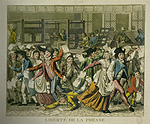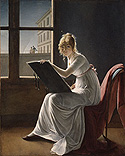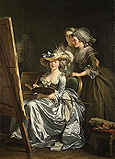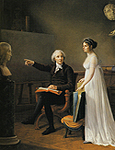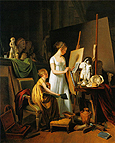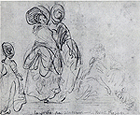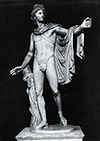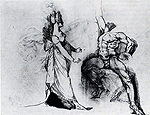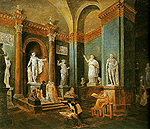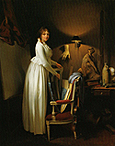The browser will either open the file, download it, or display a dialog.
|
|
The Journal des Dames et des Modes: Fashioning Women in the Arts, c. 1800-1815 |
|||||
| Discussions of Revolutionary and Napoleonic France often comment upon its androcentric, or male-centered, nature.1 The French Revolution itself has been characterized as a historical moment in which the "[t]he revolt against the father was also a revolt against women as free and equal public and private beings,"2 and much scholarship on post-Revolutionary society argues that under the notoriously chauvinistic Napoleon, women fared even worse. In 1801, Sylvain Maréchal published a pamphlet introducing (fictitious) legislation to prohibit women from engaging in such activities as "reading, writing, engraving, chanting, singing, painting, etc.;"3 several years later, the Civil Code, which severely limited women's legal rights, became law.4 The most canonical paintings of the period seem to underscore this cultural phenomenon: works such as Jacques-Louis David's Napoleon Crossing the Alps at the St. Bernard (1800) or Antoine-Jean Gros's Battle at Eylau (1808) celebrate militaristic virtue and elevate a realm that is distinctly male. Much of the scholarship devoted to the art of this period seems to corroborate this reading of the "homosocialization" of this culture.5 One could easily extrapolate from such arguments that the French art world was completely monopolized by men. | ||||||
| Or was it? I contend that the traditional narratives surrounding late eighteenth and early nineteenth-century France have lured us into adopting paradigms that deny the possibility that women, either as artists, or patrons, or critics, played a vital role in the cultural developments of this era.6 This society, to be sure, certainly privileged men as actors in the public realm, while it significantly circumscribed women's scope of influence. What I want to highlight, however, is that women increasingly engaged in the art world as both producers and consumers during the Napoleonic period, despite the dominant ideology of the separate spheres and roles for the sexes, and that this development invited significant debate. | ||||||
| Post-Revolutionary culture enabled women to participate in the visual arts in unprecedented ways.7 In much of the art produced then, we see a move away from the emphasis on the public sphere to the private space as motifs, intimating a valorization of a woman's world.8 While history painting, which played such a crucial role in Revolutionary visual culture, remained the privileged genre at the turn of the century, the rise in portraiture, landscape, and genre painting in Napoleonic France indicates this shift in values.9 Additionally, women artists such as Adélaïde Labille-Guiard and Elisabeth Vigée-Lebrun enjoyed tremendous success, and used their position to promote increased opportunities for women in terms of training and place within the Academy.10 More and more women artists began exhibiting their work in public venues and receiving recognition for their contributions at this time. While only three women artists had participated in the 1789 biennial Salon, fifty participated in the Salon of 1806—an increase in women's participation of over 1600 percent in seventeen years.11 As Nicholas Mirzoeff notes, the steps made in the early years of the Revolution towards reforming art institutions like the Academy and its Salon in a way that would enhance women's opportunities would not be matched until the late nineteenth century.12 It was during this critical juncture of the Revolutionary period that the rhetoric surrounding the modern woman artist, spectator, connoisseur, and critic began to coalesce; indeed, the discursive patterns for fashioning women in the arts throughout the nineteenth century were laid out during the time of Napoleon's power. | ||||||
| Women's journals, which often published art-related materials, have been largely overlooked in discussions of developments in late eighteenth-and early nineteenth-century French visual culture.13 This is surprising, given that bibliographies on art criticism of this period frequently cite items from these publications.14 Examination of some of these women's journals suggests a place for women in the art world that was unimaginable under the ancien régime. For example, one edition of the Le Petit Magasin des Dames reproduced Bruun-Neergard's "Sur un ouvrage de mademoiselle Julie Charpentier, artiste," and published a lengthy treatise titled "Dialogue sur les Ouvrages des Dames au salon de Peinture."15 In this article I will give sustained attention to how the Journal des Dames et des Modes, (hereinafter, sometimes, the Journal), the leading women's journal in Napoleonic France, registered the complicated subject of women's involvement in the arts. Indeed, analysis of myriad articles, letters to the editors, Salon reviews, and fashion plates published in this periodical indicates that the topic of women in the arts was a highly complex—even contentious—one. I will argue that the visual and literary culture constructed within the Journal des Dames et des Modes provides an excellent case study on the formation of the discourse surrounding women's participation in the visual arts at this critical historical moment, and also lays out various rhetorical approaches that will be taken in later nineteenth-century considerations of this topic. | ||||||
|
The Journal des Dames et des Modes served as a significant disseminator of cultural mores in post-Revolutionary France.16 In 1797, Jean-Baptiste Sellèque and Pierre de La Mésangère founded the Journal, which appeared every five days and was available through subscription, and advertised it as offering the public information on the latest activities, news, and fashions of Paris. La Mésangère, a former cleric who was trained in philosophy and the arts, served as the Journal's editor for much of its duration. It ended publication in 1839. Purportedly, he exercised a great deal of control over the design and execution of the engravings as well as over the textual material published in the Journal des Dames et des Modes.17 It is worth noting that La Mésangère's key collaborator during the Napoleonic period was a woman, Albertine Clément, née Hémery, a well-known figure in both journalistic and cultural circles in post-Revolutionary France, and that several women were regular contributors to this journal during this era.18 Although initially indicating some interest in political activism in the early years of its publication, the Journal became increasingly focused on those subjects it deemed relevant to its female readership, ranging from literature and the arts to fashion, education, and issues related to domestic life.19 A caricature of newspaper criers that was published around 1800 (fig. 1) suggests that this journal occupied a significant position in the early nineteenth-century periodical press in France. In this image, the central figure, dressed in elegant attire and treated with a high degree of detail, prominently displays the Journal des Dames et des Modes. | |||||
| In her comprehensive study of this journal, Annemarie Kleinert drew general conclusions about its readership. She determined that the journal targeted bourgeois women between the ages of 18 and 40 years old who could afford the annual subscription rate of 10 livres, and that the majority of subscribers during the period from 1800 to 1815 were from the provinces. Certainly, the interests and issues of this sector of post-Revolutionary society must have largely determined the content of the Journal des Dames et des Modes. That said, we should keep in mind that the Journal was probably read by children, servants, and other individuals in the subscriber's home, including men, and that it was made available in several cabinets de lecture (reading rooms). Kleinert estimates that during the Napoleonic era as many as eleven thousand individuals a year in France alone read the Journal des Dames et des Modes, and that it was disseminated throughout Europe (in urban and provincial locales) both in its original form and via the myriad publications that essentially plagiarized its material.20 Thus, it seems probable that the Journal's visual and literary expressions on women's artistic activities were formative to the idea—if not necessarily the realities—of the woman artist, viewer, critic, and connoisseur, in Napoleonic France. | ||||||
| Significantly, the Journal des Dames et des Modes began publication at a time when there was significant fluidity to how class and women's roles in the new social order were defined. Indeed, the post-Revolutionary period (particularly the Directory and Consulate periods) held some promise for women aspiring to positions within the larger public sphere.21 Moreover, it is at this historical juncture that a definition of bourgeois femininity was beginning to coalesce, and thus, the discourse that framed the configuration of this ideal of womanhood—such as found in the Journal des Dames et des Modes—should be examined with interest. While the Journal addressed itself to the bourgeois woman, to be sure, we must consider how the ascendancy of this nascent and amorphous class influenced the production of values for French society as a whole. And although the ideal of bourgeois femininity (in which motherhood and domesticity were the chief components) was not universally embraced—on either ideological or practical grounds—we cannot deny that this ideal held some sway over the public imagination. Study of the art-related items published in the Journal des Dames et des Modes enables us to better understand the constant negotiations between the concept of bourgeois femininity and the emergence of the modern woman as producer and consumer of art in post-Revolutionary France. | ||||||
|
For example, the contents of the Journal seem to promote the idea that the genteel bourgeoise was educated on those issues central to contemporary artistic debates and possessed a particular knowledge of prominent women artists of the period. It published articles on key issues of late eighteenth-and early nineteenth-century aesthetics, such as "État de la Peinture chez les Grecs modernes," an extract from Denon's exegesis on the Medici Venus, and, interestingly, a piece titled "État des Arts au Japon," and announcements of art publications were frequently given in its pages. The announcement of the sixteenth volume of the Annales du Musée et de l'Ecole moderne des Beaux-Arts found in journalist pages is followed by the remark: "Not one work by a woman is mentioned in this first section, but we must point out that of the thirty six plates, twelve bear the signature of Madame Lingée, and that not one of hers spoils the collection."22 Additionally, there is a review of the Salon of 1808, not cited in the bibliographic literature of Salon criticism, that focuses exclusively on the contributions of women artists. The critic Le Centyeux (widely believed to be pseudonymous for La Mésangère) writes:
This male-authored critique of women exhibiting in the Salon is fairly laudatory, and thus prevents us from drawing the hasty conclusion that the Journal des Dames et des Modes perpetuated only misogynistic ideologies—an accusation made against many of the so-called ladies' journals published in nineteenth century France.24 The above listing of women artists, along with contributions such as a biographical article on Angelica Kauffmann and an excerpt from the popular pamphlet Arlequin au Musée that considered the work of Angelique Mongez, mark the editor's belief that the professional woman artist was of interest to the readers of the Journal des Dames et des Modes.25 |
||||||
| The subject of the appropriateness of a woman pursuing an artistic vocation garnered interest throughout the course of the nineteenth-century; apparently, this topic was perceived as having enough currency to the readership of the Journal des Dames et des Modes to warrant several commentaries in this periodical. In one article, it was noted that "young ladies are given a box of assorted paints and crayons, just as twenty years ago, they would have been given a work-basket."26 It is unclear as to whether or not the author of this contribution found this a phenomenon to be applauded; such statements exemplify how the discourse on women in the arts in Napoleonic France was riddled with ambiguity. Fashion plates that accompanied each issue of this journal gave visual testimony to this heightened interest in women's artistic engagement.27 Indeed, women in fashion plates were sometimes presented in the act of sketching and drawing, as shown in a plate that appeared as an insert in an 1802 issue of the Journal des Dames et des Modes (fig. 2). | ||||||
| Significantly, the plates featuring its models as artists often intimate the ways in which gender entered into nineteenth-century discourse regarding women in the arts. A fashion plate published in 1803, shows a woman painting a male figure on a large canvas (fig. 3). As the young woman is working on a large-scale representation of a male figure, one could argue that this illustration defies admonitions given to women artists to temper their ambitions and to attempt only landscapes and still life paintings. However, this image can also be read as a reinscription of patriarchal ideology in that it seems to promote the idea that the young woman will be able to attract a lover through her amateurish artistic abilities. Here, the model has conjured up a handsome young man who appears to hold out the promise of a desirable union. This image stands in contrast to Marie-Denise Villers's Young Woman Drawing (fig. 4), exhibited in the Salon of 1801, whose featured artist has repudiated romance (as emblematized by the couple shown beyond the artist's window) in favor of art. Whereas Villers's painting perhaps argues for the serious, even professional woman artist, this fashion plate appears more intent on emphasizing art as means to love and marriage than on advocating art as a viable vocational pursuit for women. | ||||||
| Another plate published in the Journal des Dames et des Modes in 1803 suggests how women's engagement with art was mediated by men. This engraving, which shows some similarities to Villers's painting of the year before, and thus intimates how high art may have affected the look of period fashion plates, displays a model dressed à la grecque and sketching an antique bust (fig. 5). This detail not only underscores the cultural fashion for the classically inspired; it also functions as a reminder to the viewer of the omnipresence of men in the realm of art. Here, the male presence is asserted by the representation of ideal beauty in the form of a classical bust. It is true that several contemporary women artists' depictions of their studios featured male busts as accoutrements, as exemplified by Labille-Guiard's Self-Portrait with Two Students of 1785 (fig. 6) and Constance Mayer's1801 Self-Portrait of the Artist with Her Father and Daughter (fig. 7), and that their inclusion may be interpreted as countenancing women's artistic activities.28 While this is one way of reading the function of the bust in this fashion plate (fig. 5), there are other possible meanings. In this illustration, the antique bust is the artist's solitary prop and it hovers mid-air in a kind of phantasmic manner. Perhaps the rationale behind this depiction has something to do with the illustrator's need for an economy of detail; however, this device, with its distinctly unsettling effect, could be read as a declaration that the women artist could not escape the constant monitoring of their activity—or the scepter of men's dominance in this arena. | ||||||
| Moreover, the bust in figure 5 introduces a kind of sexual tension into the work in which the female artist and male bust seem to be engaged in a tête-a-tête, with the large sketchbook serving as a connecting device between the two figures. This image also reiterates the position that the "accomplished woman" should have some training in the arts so as to make a more desirable match than one without such talents.29 Given that questions of love, marriage, and domesticity were central components of the essays and editorials in the Journal des Dames et des Modes—and indeed, in Napoleonic cultural discourse in general—it does not seem improbable that gender dynamics entered into the accompanying engravings as well.30 In sum, the treatment of the woman artist in the fashion plates published in this journal offer up multiple meanings, and thus testify to the complexities attending questions of women's involvement in the visual arts. | ||||||
|
The ways in which an education in the arts might actually encourage devotion to hearth and home and thereby support the rising cult of domesticity in early nineteenth-century France is suggested in an 1812 letter to the editor of the Journal des Dames et des Modes. In this letter (which, I believe, was probably penned by La Mésangère),31 a mother queried whether it was more profitable to educate a woman in the visual arts or to train her in music. The editor responded that because music incites the passions, it might be dangerous to employ a music master for this woman's daughter, and thus he advised training in sketching and painting instead. He proffers:
La Mésangère's encouragement regarding women's training in art clearly reinforces patriarchal conceptions of the appropriate spaces and activities of femininity. Drawing and painting are valorized because not only can they be practiced within the private sphere—but also because these artistic activities will actually tie women to it. Furthermore, the vocabulary used by the author stresses the ways in which artistic creativity mirrors childbirth and elicits feelings of exaltation over one's art that are similar to those evoked by motherhood when he writes that "she smiles at the objects which are born of her colors" and calls the site of her production a "creative space." Interestingly, the editor's response placates those fears of impropriety in pursuing training in drawing and painting by stressing its conduciveness to maintaining the Napoleonic ideal of women as domestic creatures and mothers—rather than suggesting that this will encourage young women to become public figures, a fear held by many concerned over the figure of the woman artist. Paintings such as Louis-Léopold Boilly's A Painter's Studio of about 1800 (fig. 8), which shows a woman artist in a claustrophobic space hedged in by the objects of her craft, provides visual corroboration of this advice. This editorial response perpetuates a masculinist vantage point, to be sure, but the stridency of its language signals that women's incursions into the male-dominated realm of art were developments that unsettled conventional modes of framing this field. |
||||||
|
While championing the virtues of studying the visual arts over music, the editor of the Journal des Dames et des Modes is quick to emphasize that this concerned mother's daughter should focus on still life and landscape painting rather than on history painting, as this may stretch the limits of decorum. La Mésangère admonishes:
Becoming a history painter necessitated the study of representations of the nude in art, as well as access to the nude model. Recent scholarship suggests that there were opportunities for such study in the Napoleonic era. By 1800, female students could attend anatomy classes given by the surgeon Sue and also by the École du Modèle Vivant at Versailles, and artist Adele Romilly reported that David, Régnault, and Guérin all provided mixed studios that offered courses on life drawing from the nude.34 The potentially dangerous relationship between women studying the nude in art and women's sexual desire comes to the fore in this editorial from the Journal des Dames et des Modes, in which the editor continues to exhort, "…[l]andscapes and flowers are the only genre that is proper for young women in the career of the liberal arts. . . By fixing on the canvas the most gracious of what nature offers, their mind will take on some of the color and sweetness: seductive ideas do not dare approach them . . .35 Thus, careful circumscription of subject matter will guard against the woman artist's excursions into the forbidden realms of sexuality. |
||||||
|
In addition to addressing questions of propriety for women artists, items in the Journal des Dames et des Modes mark a keen interest in women's roles as spectators of art. An 1808 letter to the editor raises the issue of women's visibility in the Salon setting and, ultimately, in the larger public sphere. In this letter, "Fanny Tatillon" (the appelation is surely a pseudonym, given that the verb "tatilloner," which means "to meddle," was a popular descriptor for a busybody) presents the female spectator as a narcissistic and superficial figure. In this piece, "Fanny Tatillon"—most likely another creation by the editor36—discusses the best time of day to attend the Salon, for, as she remarks, it is a place where "I like very much to see, [but] I prefer perhaps more to be seen."37 She continues:
In the discussion of women artists, "Fanny Tatillon" continues her nonsensical prattle, deriding such esteemed artists as Jeanne-Elisabeth Chaudet, Elisabeth Vigée-Lebrun, and Marie-Guillemine Benoist:
This fictitious writer devalues the activities of those women artists and viewers who were visiting the Salon in increasing numbers in the early nineteenth century; Hubert Robert's early nineteenth-century sketch Women Entering the Museum (fig. 9) may be viewed as a marker of this development. Truly, "Fanny Tatillon" presents the Salon as a public spectacle rather than a place where one goes to become edified and culturally enriched, and reinforces stereotypical images of the female viewer as caught up in issues of self-display and sociability rather than as genuinely interested in art. In the end, this piece minimizes the possibility that women could engage with art and aesthetics in a judicious and meaningful manner. That La Mésangère felt compelled to create such a figure as "Fanny Tatillon" is highly suggestive of the anxieties elicited by the women producers and consumers of art in the Napoleonic period. |
|||||
| The ventriloquism at play in this and other male-authored critiques published under a female pseudonym, as found in several items in the Journal des Dames et des Modes, is a fascinating development of this period that deserves further consideration. Roger Bellet has demonstrated that there are known instances in late eighteenth- and early nineteenth-century France when men published under a female pseudonym.40 The adoption of a female persona by La Mésangère may have been a strategy to convince readers that women, as well as men, had serious doubts regarding the viability of women's participation in the arts. Furthermore, by assuming the role of the female subject, La Mésangère effectively colonizes the feminine, a trend that had extended into the realm of Napoleonic visual culture by means of valorizing the ephebic male in literature, art and fashion.41 This kind of play with gender suggests the instability of such constitutive categories in post-Revolutionary France. In the end, it appears that the editor of the Journal des Dames et des Modes believed the appropriation of female subjectivity was an effective means of promoting a decidedly patriarchal agenda. One wonders how often this kind of ruse was employed in other presentations of the woman artist, viewer, critic, and connoisseur in the course of the nineteenth century. | ||||||
|
In what may be another instance of this ventriloquism, the Journal des Dames et des Modes published a piece in 1807 that considered the subject of women viewing the male nude. In this riveting account, titled "La Provençale devant l'Apollon du Belvédère, au Musée Napoléon" and signed "Madame . . . ., témoin oculaire," which was purportedly translated from a German journal and then published in this periodical, readers were warned against the dangers of becoming enchanted before the quintessential Greek sculpture (fig. 10). This extraordinary piece deserves to be quoted in its entirety:
This description of a woman overcome by this representation of divine beauty is highly provocative and speaks to concerns over the place of the female spectator in Napoleonic culture.43 The inclusion of this tale in the Journal des Dames et des Modes can be read as a means of frightening young women into circumscribing their viewing activities, for the clear message is that looking at art can send women into an irrecoverable state of delirium. Moreover, the tale seems intent upon emphasizing that the woman's adoption of the position of viewer can make her senseless to the fact that she—and not just the artwork—become the spectacle, and hence, the woman spectator risks personal health and the loss of decorum in the eyes of the public. Women's visibility, whether as artists, subjects, or consumers is of paramount concern to cultural critics throughout the nineteenth century. Contemplation of art, and particularly representations of the male nude, can be personally and socially compromising. Medical discourse and other literature of the period bolstered this position. For example, in his Des Maladies des femmes (1784), Nicolas Chambon de Montaux suggested that the over-stimulation of women's imagination, as might be induced by such activities as the reading of novels or viewing of spectacles, could permanently damage their nervous system.44 While the male artist/viewer was not impervious to lovesickness elicited by the representation of the (female) nude—the proliferation of art and literature devoted to the Pygmalian theme in the nineteenth century attests to the belief in such occurrences—the alternative relationship of the desiring woman spectator produced a particular charge of its own, given contemporary gender ideologies, that demands investigation.45 In the end, the conclusion given by the purportedly female eyewitness that "it would have been better for her had she never seen the statues" stands as a strident proclamation against women's involvement as viewers. |
|||||
| Additionally, this tale of a young, impressionable woman who becomes lovesick after beholding the Apollo Belvedere clearly intimates the cultural concerns over intersections between women, art, and desire that captivated post-Revolutionary culture and would permeate the rest of the nineteenth century. Anxiety over the exposure of women and children to the male nudes in David's Intervention of the Sabine Women (1799) forced the artist to pen a defense of his use of nudity in the painting—and thus, as Darcy Grimaldo Grigsby has argued, foregrounded the presence of the female viewer and declared her an integral maker of meaning in the visual culture of this period.46 Henry Fuseli's dynamic sketch of a woman before the Laocoön (c. 1800-1805) (fig. 11), wherein the stiffened arms and clenched fists of the female viewer display the appropriate reaction of shock before this virile sculpture, is yet another manifestation of this heightened interest in women looking at male nudity in art. Paintings such as Hubert Robert's Apollo Belvedere Room (1803-04) (fig. 12), where there are several women flocked around the famed sculpture, including a woman artist who crouches before the work and sketches intently, necessitate a renewed consideration of women as spectators in the modern era. Furthermore, in the account of the provincial girl's experience before the Apollo Belvedere, the line "Leave me, you others, leave me to satisfy myself with its beauty; leave me to gaze and to die" forcefully voices a woman spectator's position as one who can gain her own pleasure in looking.47 This encounter with the male nude in representation, which caused the girl to "quiver" and to become "animated as if by electricity," certainly did contain a sexual element. In sum, the heterosexual responses to these beloved works from antiquity undermine—and ideologically diffuse— Winckelmann's famous homoerotic readings of both the Apollo Belvedere and the Laocoön, thereby suggesting that we must reconsider how spectatorship of this period has been framed.48 | ||||||
| Not all representations of the female spectator in the Journal des Dames et des Modes were so derogatory, however. An extraordinary fashion plate published in 1801 not only marks the increasing visibility of women viewers, but also allows for the possibility that such a figure could function in an autonomous way within the post-Revolutionary art world (fig. 13). Here, a model has pulled a print of a reclining female nude from a portfolio and is gazing upon it. Albeit a female nude, and thus a more appropriate object of the model's regard than a representation of male nudity, it remains a provocative image vis-à-vis questions of how gender inflected early nineteenth-century spectatorship. Rather than considering a portrait or landscape or still life, the model studies the human figure and thus contradicts advice given in the pages of this same journal, such as that given in the 1812 editorial cited earlier. And rather than behold a heroic male nude—one of the primary features of the still-pervasive neoclassicism of early nineteenth-century France—she fixes her attention on an image of female nudity. This work can be read as an iteration of masculinist notions regarding a woman's position as an object. Here, there is a doubling over of the objectifying gaze—the (woman) reader of the Journal stares at the model, who in turn views the representation of the female nude. The engraving may function as part of the stratagem for using a woman subject to articulate androcentric positions; here, it is the idea that women condone and even welcome the male gaze. Alternatively, this fashion plate could be interpreted as an empowering gesture for the female connoisseur whose purview is not limited to banal subjects. There is even the possibility that this image proposes that women can be pleasured by looking at representations of the female nude.49 There are certainly paintings of women as viewers of art during this period—the various representations of women in studios by Louis-Léopold Boilly, such as The Artist's Wife in His Studio (c. 1795-1800) (fig. 14), come to mind. However, these do not stretch the limits of propriety like this fashion plate—or the painting that this work may be modeled after, Étienne Charles Le Guay's Portrait of Marie-Victoire Jaquotot (fig. 15), which shows the young miniaturist rifling through a portfolio of prints. Significantly, one of these prints features a reclining female nude that is strikingly similar to the one shown in the image published in the Journal des Dames et des Modes. In the end, this fashion plate is not only suggestive of the growing recognition of women as consumers of art, but also, it yields up a kind of frisson that provokes questions regarding female spectatorship. | ||||||
| Of central concern in the pages of the Journal des Dames et des Modes are the vision and visibility of women in the visual arts. What women painted; how women saw art and in what contexts; how their aesthetic discourse intimates sexual politics; and how the private and public spheres collapsed in the act of creating, viewing and criticizing art, apparently were of significant interest to the readership of this journal. Occupying the liminal space between the ancien régime and modernity, the Napoleonic period stands as a critical moment in the negotiation of such issues. Despite substantial scholarship on women's involvement in the visual arts in the early nineteenth century, much of the scholarship on the woman artist, viewer, critic, and connoisseur of the so-called modern period focuses on developments that occur after 1848. I hope that this article contributes to heightening interest in women artists in France before the rise of Rosa Bonheur, the women of the Académie Julian, the women Impressionists, and the creation of the Union des Femmes Peintres et Sculpteurs, and that it leads to deepening considerations of female viewership in the pre-flâneuse era, as the ways in which contemporary scholars have framed the nineteenth-century woman beholder fail to take into account earlier demonstrations of the modern female spectator.50 In sum, the conversations on art held in popular periodicals such as the Journal des Dames et des Modes mark the emergence of interest in the modern woman's participation in the arts; signal the perceived significance of this cultural phenomenon; and intimate just how contested this subject would become in the course of the nineteenth century. | ||||||
|
This is a revised and expanded version of a paper presented at the 2005 College Art Association conference. I would like to thank those who read early drafts, including Marilyn Brown, Marni Kessler, and Linda Stone-Ferrier, along with the anonymous reviewer at Nineteenth-Century Art Worldwide, for their helpful suggestions. I would also like to thank Denise Z. Davidson, Annemarie Kleinert, Martha Moffitt Peacock and Alex Potts for their kind assistance with some research questions, as well as Julie Nay, who helped finesse some of my translations. Research for this article was funded in part by a Kress Travel Fellowship, the Murphy Travel Fund of the Kress Department of Art History at the University of Kansas, and a grant from the Women's Research Institute at Brigham Young University. All translations, unless otherwise noted, are by the author. 1. The literature on the patriarchal nature of this period is vast; for an overview of the limitations placed on women in Revolutionary and Napoleonic France, see Genevieve Fraisse, Reason's Muse: Sexual Difference and the Birth of Democracy, trans. Jane Marie Todd (Chicago: University of Chicago Press, 1994); Madelyn Gutwirth, The Twilight of the Goddesses: Women and Representation in the French Revolutionary Era (New Brunswick: Rutgers University Press, 1992); Candace E. Proctor, Women, Equality, and the French Revolution (New York: Greenwood Press, 1990); and Joan B. Landes, Women and the Public Sphere in the Age of Revolution (Ithaca,NY: Cornell University Press, 1988). 2. Landes, Women and the Public Sphere, 158. 3. Sylvain Maréchal quoted in Fraisse, Reason's Muse, 2. 4. See especially James F. McMillian, "Revolutionary Aftermath: the Reconstruction of the Gender Order," France and Women, 1789–1914 (New York: Routledge, 2000), 32–44; and Susan K. Grogan, French Socialism and Sexual Difference: Women and the New Society, 1803–44 (New York: St. Martin's Press, 1992). 5. For example, see Joan B. Landes, Visualizing the Nation: Gender, Representation, and Revolution in Eighteenth-Century France (Ithaca, NY: Cornell University Press, 2001); Abigail Solomon-Godeau, Male Trouble: A Crisis in Representation (New York: Thames and Hudson, 1997); and Thomas Crow, Emulation: Making Artists for Revolutionary France (New Haven: Yale University Press, 1995). 6. See, for example, Crow, Emulation; Walter Friedlander, David to Delacroix (Cambridge, MA: Harvard University Press, 1977); Robert Rosenblum, Transformations in Late Eighteenth-century Art (Princeton: Princeton University Press, 1970). 7. For an overview of women artists of the period, consult Margaret Oppenheimer, "Women Artists in Paris, 1791–1814," (Ph.D. diss., New York University, 1996); Vivian Cameron, "Woman as Image and Image-Maker in Paris During the French Revolution," (Ph.D. diss., Yale University, 1983); and Gen Doy, Women and Visual Culture in 19th Century France, 1800–1852 (New York: Leicester University Press, 1998). See also Mary Vidal, "The 'Other' Atelier: Jacques-Louis David's Female Students," Women, Art and the Politics of Identity in Eighteenth-Century Europe, ed. Melissa Hyde and Jennifer Milam (Burlington, VT: Ashgate, 2003): 237–62; and Margaret Fields Denton, "A Woman's Place: The Gendering of Genres in Post-Revolutionary France," Art History 21 (June 1998): 219–46. 8. While this argument is made in reference to developments in early nineteenth-century British art in Ann Pullan, "'Conversations on the Arts": Writing a Space for the Female Viewer in the Repository of Arts, 1809–15," Oxford Art Journal 15, no. 2 (1992): 15–26, this phenomenon is also seen in French art of this period. 9. For discussions of the variety of art produced during the Revolution, see Régis Michel, ed., Aux armes et aux arts ! Les Arts de la Révolution 1789–1799 (Paris: Éditions Adam Biro, 1988); Jean-Jacques Lévêque, L'Art et la Révolution Française, 1789–1804 (Neuchâtel: Ides et Calendes, 1987); and Jean-François Heim, Claire Béraud, and Philippe Heim, Les Salons de Peinture de la Révolution Française (1789–1799) (Paris: C.A.C. Sarl Édition, 1989). For treatments of genre and portrait painting in post-Revolutionary France, see Susan Siegfried, The Art of Louis-Léopold Boilly: Modern Life in Napoleonic France (New Haven: Yale University Press, 1995) and Tony Halliday, Facing the Public: Portraiture in the Aftermath of the French Revolution (New York: Manchester University Press, 1999), respectively. 10. For discussions of these increased opportunities for women artists, see Doy, Women and Visual Culture, and Mary Sheriff, The Exceptional Woman: Elisabeth Vigée-Lebrun and the Cultural Politics of Art (Chicago: Chicago University Press, 1996). 11. Oppenheimer, "Women Artists in Paris," 2. 12. Nicholas Mirzoeff, "Revolution, Representation, Equality: Gender, Genre, and Emulation in the Academie Royale de Peinture et Sculpture, 1785–93," Eighteenth-Century Studies 31, no.2 (1997-98): 169. 13. Overviews of women's journals in late eighteenth- and early nineteenth-century France are provided in Jeanne Brunereau, Presse féminine et Critique littéraire de 1800 à 1830 (Paris: Eve et son éspace creatif, 2000); Nina Rattner Gelbart, Feminine and Opposition Journalism in Old Regime France: "Les Journal des Dames" (Los Angeles: University of California Press, 1987); and Evelyne Sullerot, Histoire de la Presse féminine en France, des Origins à 1848 (Paris: Armand Colin, 1966). 14. See Richard Wrigley, The Origins of French Art Criticism from the Ancien Régime to the Restoration (New York: Oxford University Press, 1993); and A Bibliography of Salon Criticism in Paris from the Ancien Régime to the Restoration, 1699–1827, ed. Neil McWilliam (New York: Cambridge University Press, 1991). 15. Tönnes Christian Bruun-Neergard "Sur un ouvrage de mademoiselle Julie Charpentier, artiste, " Le Petit Magasin de Dames (Paris: Delaunay, Debray, Delance, 1807), 147–54; and St. L . . . (M.) "Dialogue sur les Ouvrages des Dames au salon de Peinture," Le Petit Magasin de Dames (Paris: Delaunay, Debray, Delance, 1807): 155–79. 16. The most in-depth study of this journal is found in Annemarie Kleinert, "Le Journal des Dames et des Modes" ou la Conquête de l'Europe féminine (1797–1839) (Stuttgart: Jan Thorbecke, 2001). See also Sullerot, Histoire de la presse feminine, chapters 7 and 8. 17. On La Mésangère's involvement with the content of the Journal, see Kleinert, especially chapter 2. 18. According to Sullerot, in Histoire de la presse feminine, and Kleinert, in "Le Journal des Dames et des Modes," there were several female contributors, including Caroline Wuiet and Constance de Salm, née Pipelet. Unfortunately, it is impossible to know with certainty if any of these women authored art-related pieces in the Journal des Dames et des Modes, as these were either unsigned, signed with initials, or signed with some kind of pseudonym. 19. Michael Polowetzky, A Bond Never Broken: The Relations between Napoleon and the Authors of France (Madison, NJ: Fairleigh Dickinson University Press, 1993), 85. This drift towards ostensibly more benign material was doubtlessly encouraged by the 1800 press censorship laws that targeted political publications; records suggest that the Journal des Dames et des Modes escaped censorial scrutiny as it was deemed a cultural journal. To be sure, the cultural discourse of the Revolutionary and Napoleonic eras masked political issues, and the treatment of social activities and mores within this publication should be read for its potentially subversive political content. See Susan Siegfried, "The Politicisation of Art Criticism in the Post-Revolutionary Press," Art Criticism in Nineteenth-Century France, ed. Michael R. Orwicz (New York: Manchester University Press, 1994), 9-28; and Richard Wrigley, The Politics of Appearance: Representations of Dress in Revolutionary France (New York: Berg, 2000). 20. For additional information on readership, see Kleinert, "Le Journal des Dames et des Modes," chapters two and three. 21. Compelling arguments on the empowering effects of the post-Revolutionary order on women in culture are made in Carla Hesse's "French Women in Print, 1750–1800: An Essay in Historical Bibliography," Studies in Voltaire and the Eighteenth Century 359 (1998): 65–82; and Gen Doy's Women and Visual Culture. 22. Anonymous [unsigned], "Annoncé le seizième Tome du Annales du Musée et de l'École moderne des Beaux-Arts," Journal des Dames et des Modes 70, December 20, 1808, 556. 23. Le Centyeux, "Paris," Le Journal des Dames et des Modes 58, October 20, 1808, 457–58: "Quarante-huit dames peintres sont inscrites sur le livret: deux seulement ont exposé tableaux histoire. Celui de Mme. Mongez (Orphée aux Enfers) est vu avec intérêt. Les tableaux de Mme Chaudet ont la fermeté de touche accoutumée. On ne reconnoît plus Mlle Gérard. Pour la composition, la Famille de Picard, par Mme Auzou, est un des jolis tableaux de chevalet. Psyché et la Vérité dans le Vin, par Mlle Bounieu, font plaisir. On est affrayé de la profondeur d'études qu'a exigé le Flambeau de Vénus, par Mlle Mayer (Constance)." All textual quotations from the Journal des Dames et des Modes cited in this article remain in their original form, despite the errors (typographical and otherwise). 24. See Brunereau, Presse feminine et Critique littéraire. 25. Anonymous [unsigned], "Sur Angelica Kaufmann," Journal des Dames et des Modes 9, February 15, 1808, 70–71; and anonymous [unsigned] "L'Arlequin au Musée," Journal des Dames et des Modes 68, December 10, 1808, 540–41. 26. Quoted in George Leventine, The Dawn of Bohemianism: The Barbu Rebellion and Primitivism in Neoclassical France (University Park: Penn State University Press, 1978), 32. 27. Artists who contributed engravings to this journal include Claude Louis Desrais, Philibert Debucourt, Carle and Horace Vernet, Pierre-Charles Baquoy, Louis-Marie Lanté, and Gavarni. 28. On the inclusion of representations of men in women's self-portraits, see Liana De Girolami Cheney, et al., Self Portraits by Women Painters (Brookfield, VT: Ashgate, 2000) and Frances Borzello, Seeing Ourselves: Women's Self-Portraits (New York: Harry N. Abrams, 1998). 29. Consideration of women in the arts in late eighteenth- and early nineteenth-century Britain is given in Ann Bermingham's "The Aesthetics of Ignorance: The Accomplished Woman in the Culture of Connoisseurship," Oxford Art Journal 16, no. 2 (1993): 3–20. 30. For a discussion of the cult of domesticity within the framework of the periodical press in Napoleonic France, see Elizabeth Colwill, "Women's Empire and the Sovereignty of Man in La Décade Philosophique, 1794-1807," Eighteenth-Century Studies 29 no. 3 (1996): 265–89. 31. In a recent conversation at the 2005 ASECS conference in Las Vegas, Denise Z. Davidson and I found that our research on the Journal des Dames et des Modes had led us to draw similar conclusions: that the letters to the editor, which were most often signed with women's names, were fictitious constructs. Whereas Davidson allows for the possibility that these were penned by staff members, I tend to believe that the largely female staff of this periodical (among whom were noted feminists) would have protested against such demeaning representations of women, and that it was La Mésangère who created these letters as a means of pontificating on subjects of his choosing without appearing too heavyhanded. I thank Davidson for her generosity in discussing her work on this periodical, and refer readers to her article, "Representing the Female Consumer in Early Nineteenth-Century France: Le Journal des Dames et des Modes," a work in progress. 32. Anonymous [signed: —–], "Le Dessin et la Peinture préférables à la Musique sous la Rapport de l'Éducation des Demoiselles," Journal des Dames et des Modes 18, March 31, 1812, 142: "Le dessin, au contraire, et la peinture sont la plus douce et la plus forte chaine qui puisse retenir une femme au sein de ses foyers, d'où elle ne s'éloigne qu'à regret, quand les bienséances lui en font un devoir. Quelle est intéressante, lorsque sa palette dans une main et ses pinceaux dans l'autre, elle sourit aux objets qui naissent des ses couleurs! Tout entière à cette espèce de création, les distractions la fatiguent, les visites l'importunent, Paris n'est rien pour elle." 33. Anonymous [signé: —–], Le Dessin et la Peinture préférables," Journal des Dames et des Modes 18 (March 31, 1812),142: "Mais garde-toi, mère prudente, de laisser ta fille dessiner ou peindre autre chose que des fleurs, des prés, des bois. En vain elle voudroit s'élever à la dignité de l'histoire. Que de tems, et quels talens il faut pour y atteindre. Osera-t-elle dessiner la figure et peindre le nu, qu'il est pourtant nécessaire de faire sentir sous le jeu des draperies? La pudeur s'est allarmeroit." 34. See Doy, Woman and Visual Culture, 97. 35. Anonymous [signed: —–], "Le dessin et la peinture préférables," Journal des Dames et des Mode 18 (March 31, 1812)142: "Le paysage et les fleurs sont le seul genre qui convienne aux demoiselles dans la carrière des art libéraux. . . En fixant ainsi sur la toile ce que présent de plus gracieux la nature champêtre, leur esprit en prend le coloris et la douceur : les idées séductrices n'osent approcher." 36. Gen Doy cites this piece as an example of a ploy in which a woman assumes the guise of a reader who approaches the editor with a request to write about the Salon (Doy, Vision and Culture, 146). However, it seems highly unlikely that a serious woman journalist would have accepted the moniker "Tatillon," given the connotations of this term. Clearly, this descriptor had cultural relevancy, as an entry titled "Tatillonage" was published only a few years earlier in this same journal. Anonymous [unsigned], "Tatillonage, " Journal des Dames et des Modes 60, (June 19, 1804), 480. 37. Fanny Tatillon, "Au Rédacteur," Journal des Dames et des Modes 61, (November 5, 1808), 481: "J'aime beaucoup à voir, je préfère peut-être encore être vue." 38. Tatillon, "Au Rédacteur," Journal des Dames et des Modes 61 (November 5, 1808), 481–82: "Je ne m'y rends qu'à midi, parce que c'est l'heure de beau monde ; à dix heures, le livret en main, la lorgnette braquée, vous ne rencontrez la que des connoisseurs qui, le regard fixe, l'air pensif, apprient, comparent et jugent; ce sont des êtres froids et passif dont le seul enthousiasme se borne aux beaux-arts, et que la vue de la plus jolie femme ne détourneroit pas un seul moment de l'attentions qu'ils donnent aux chefs-d'œuvre." 39. Tatillon, "Au Rédacteur," Journal des Dames et des Modes 61 (November 5, 1808), 482. "Je suis femme: en fait d'arts, c'est à mon sexe que je dois mon premier hommage. Où êtes vous, charmante Chaudet, vous si connue par l'education d'un chien; mais que vois-je? votre carlin n'a pas fait de progrès, je l'aimois mieux quand il épeloit avec tant de grâces; et vous divine Lebrun, hélas! votre génie est un peu étient, à peine en retrouve-t-on quelques traces dans la figure de Mme Catalani! Madame Benoît, votre pinceau est sévère comme celui d'un homme; M. Laurent, voire touche est fade comme celle d'une femme." 40. See Roger Bellet, "Masculin et feminine dans les pseudonyms des femmes de lettres au XIXe siècle," Femmes de lettres au XIXième siècle: autour de Louise Colet, ed. Roger Bellet (Lyon: Presses universitaires de Lyon, 1982): 249–81. 41. The idea of the colonization of the feminine in post-Revolutionary culture is explored in Abigail Solomon-Godeau, Male Trouble: A Crisis in Representation; and Doris Y. Kadish, Politicizing Gender: Narrative Strategies in the Aftermath of the French Revolution (New Brunswick,: Rutgers University Press, 1991). 42. Anonymous [signed: Madame . . . ., témoin oculaire], "La Provençale devant l'Apollon du Belvédere, au Musée Napoléon," Journal des Dames et des Modes 26, May 10, 1807, 207–8: "Je l'ai vue; c'étoit une grande femme, svelte, parée de tous les agrens de la première jeunesse. Entrainée malgré moi par ses charmes, mes yeux suivirent tous ses mouvemens. Parvenue devant l'Apollon, elle frémit et s'arrêta comme frappée du tonnerre. Peu-à-peu un feu brillant étincela de ses yeux, qui d'abord avoient été clairs et fixes; tout con être fut anime comme électriquement; on voyoit se passer en elle la plus singulière métamorphose… Après avoir ainsi contemplé long-tems, elle se mit à exprimer avec une agéable confusion ce qu'elle sentoit. Il seroit impossible de répéter plus que le sens de ses paroles, et la voix : 'Je n'ose pas lever mes yeux vers le dieu; je n'ose pas baisser les yeux devant celui dont l'aspect me rend si heureuse. Est-ce un ouvrage humain, ou une création divine? Le modèle en est-il sur la terre ou au ciel? Vous dites que c'est là l'Apollon du Belvédere; mais ce que je vois n'est pas du marbre, c'est le dieu resplendissant de gloire. Laissez-moi, vous autres, laissez-moi me rassasier de sa beauté ; laissez-moi le regarder et mourir. . . ' Enfin sa compagne, sa sœur aînée, parvint à l'en arracher à force de caresses et de prières; elle s'en alla en pleurant. Un jour, quelques mois après, je revins au salon; le gardien, auquel j'avois demandé des nouvelles de la Provençale, me dit : 'La pauvre petite, elle auroit mieux fait de ne jamais venir voir les statues. Tantôt assise, elle regardoit Apollon les mains jointes; s'il n'y avoit personne, elle se mettoit à genoux et pleuroit. D'autres fois, elle apportoit des fleurs et les plaçoit sur le piédestal. Un matin qu'elle étoit entrée clandestinement, nous la trouvâmes en dedans du grillage, sur le piédestal, épuisée de larmes et évanouie; toute la salle étoit parfumée de fleurs; un grand voile de mousseliné des Indes, bordé d'or, drapoit avec goût la statue. Par respect pour l'état déplorable où se trouvoit cette jeune personne, ou écarta le public jusqu'à ce que ses parens fussent arrivés pour la chercher. Ils eurent de la peine à l'emmener. Dans son délire, elle se declaroit prêtresse de dieu, et vouloit rester pour le servir. Depuis nous ne l'avons plus revue; mais elle étoit trop-intéressant pour être de sitôt oubliée.' The origins of this tale are unknown. Later in the century, the British actress and writer Fanny Kemble, in front of the Vatican Apollo, will write: "I could believe the legend of the girl who died for love of it; for myself, my eyes swam in tears and my knees knocked together, and I could hardly draw my breath while I stood before it." Frances Anne Kemble, A Year of Consolation, vol. 2 (London: E. Moxon,, 1847), 11–12. 43. For a discussion of the ambivalence engendered by eighteenth-century women looking at classical sculpture, see Chloe Chard, "Effeminacy, Pleasure and the Classical Body," Femininity and Masculinity in Eighteenth-century Art and Culture, ed. Gill Perry and Michael Rossington (New York: Manchester University Press, 2004): 142–161. 44. See Nicolas Chambon de Montaux, Des Maladies des femmes, 2 vols. (Paris: Hôtel Serpente, 1784). 45. For an overview of the currency of this myth, see Alexandra K. Wettlaufer, Pen vs. Paintbrush: Girodet, Balzac, and the Myth of Pygmalion in Post-Revolutionary France (New York: Palgrave, 2001). One example of this found late in the century is the 1883 novella L'Aveugle, in which a male nude model ultimately seduces a female painter. For a discussion of this novella and its implications for women artists/spectators, see Tamar Garb, "The Forbidden Gaze," Art in America 79 (1991): 146–52. 46. See Darcy Grimaldo Grigsby, "Nudity à la grecque in 1799," Art Bulletin 80, no. 2 (June 1998): 311-35, especially pages 327–331. 47. For further consideration on the subject of desire and female spectatorship of this period, see my "C.W., académicienne: Caroline Wuiet and the Post-Revolutionary Woman Art Critic" in Vanishing Acts: Women and the Art World in 19th Century France, ed. Wendelin Guentner, work in progress. 48. For Winckelmann's homoerotic readings of the Apollo Belvedere and the Laocoön, I refer the reader to Alex Potts, Flesh and the Ideal: Winckelmann and the Origins of Art History (New Haven: Yale University Press, 1994). 49. On the issue of scopophilia and the female spectator, see the pathbreaking studies of Teresa de Lauretis, Alice Doesn't: Feminism, Semiotics, Cinema (Bloomington: Indiana University Press, 1984); and Laura Mulvey, "Visual Pleasure and Narrative Cinema," Screen 16 (Autumn 1975): 347–53. The possibility that there existed a kind of homoerotic counterculture for women in post-Revolutionary France deserves further consideration. 50. For scholarship on female spectatorship relevant to this period, see Mary Sheriff, Moved by Love: Inspired Artists and Deviant Women in Eighteenth-Century France (Chicago: University of Chicago Press, 2004); Angela Rosenthal, "She's Got the Look! Eighteenth-Century Female Portrait Painters and the Psychology of a Potentially 'Dangerous Employment'," in Portraiture: Facing the Subject, ed. Joanna Woodall (New York: Manchester University Press, 1997), 147–66; Gen Doy, "What do you say when you're looking?," Women's Art Magazine 70 (June/July 1996): 10–15; Jann Matlock, "Seeing Women in the July Monarchy: Rhetorics of Visibility and the Women's Press," Art Journal 55, no. 2 (1996): 73–84; and Carol Ockman, "A Woman's Pleasure: The Grande Odalisque," in her Ingres's Eroticized Bodies: Retracing the Serpentine Line (New Haven: Yale University Press, 1995), 32–65. |


